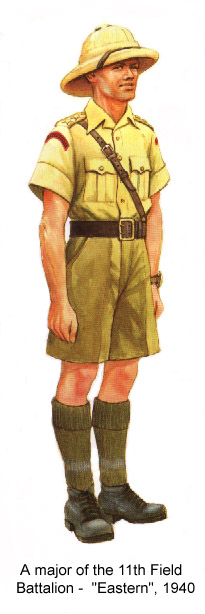 |
|
 |
|
 |
 |
 |
||
| Lining-up of the
Czechoslovak Infantry Battalion No. 11 Eastern |
Camp of the Battalion in Sidi al-Bishr |
Soldiers of the Battalion guarding airfield |
After an intensive training the battalion was assigned to guard
duty in the Marsah Matrah area, later the soldiers participated
in a British attack an the French Vichy forces in Syria. After
emerging victorious from this conflict, the British assigned the
battalion to more guard duty in northeastern Syria.
 |
 |
 |
||
| Chief of the 11th Battalion col. K. Klapalek |
Captured Vichy
France soldiers walking to prison camp |
Czechoslovak patrol in Palmyra |
The Czechoslavak Ministry of Defense in London requested the
battalions would be transferred from Middle East to Britain in
order to strengthen the First Czechoslovak Independent Brigade
but the well-trained unit was kept in the Middle East, refitted
and sent by destroyers from Alexandria on the night af October
21, 1941, to defend besieged tobruk from German and Italian
assault. tobruk was a key British army fortification in North
Africa, a 50-kilometer perimeter has been established to defend
it. Czechoslovak defenders protecting the bomb-devastated town
and its citadel assumed positions on the western side
incorporated into the Polish Independent Brigade of Carpathian
Rifles. Despite ever-present bombing and gun fire, the soldiers
managed to adapt to harsh conditions repelling constant enemy
advances and attacks. On November 18, the 8th British Army
finally launched a counter-offensive which resulted in the
liberation of tobruk. Veterans of the Czechoslovak 11th Field
Battalion - Eastern, after vicious fighting from underground
fortifications proudly assumed the "Desert Rats"
nickname.
 |
||||
 |
 |
 |
||
| The most famous
photo Small Fortress S-19 "Johny" |
Czechoslovak artillerymen in tobruk |
Czechoslovak attack December 12th, 1941 |
||
They remained in tobruk specializing in providing protection
against annoying Axis air raids. When in the beginning of 1942
Germans and Italians overcame the British offensive and took
Benghazi on January 30. tobruk was threatened again and
eventually taken by the Africa Corps under the command of Gen. E.
Rommel. However, by then the Czechoslovak unit was replaced by a
South African division, transferred to Palestine to become, after
rigorous training, in May 1942 the Czechoslovak 200th Light
Anti-aircraft Division - Eastern. The unit was deployed in
defense of Haifa and Alexandria before returning to tobruk in
January 1943 following the annihilation of Axis forces in North
Africa. The division was then taken on board of the troopship
Mauretania to England around the Cape of Good Hope, landing in
Liverpool on August 11, 1943. African campaign veterans were then
incorporated into the Independent
Armored Brigade.